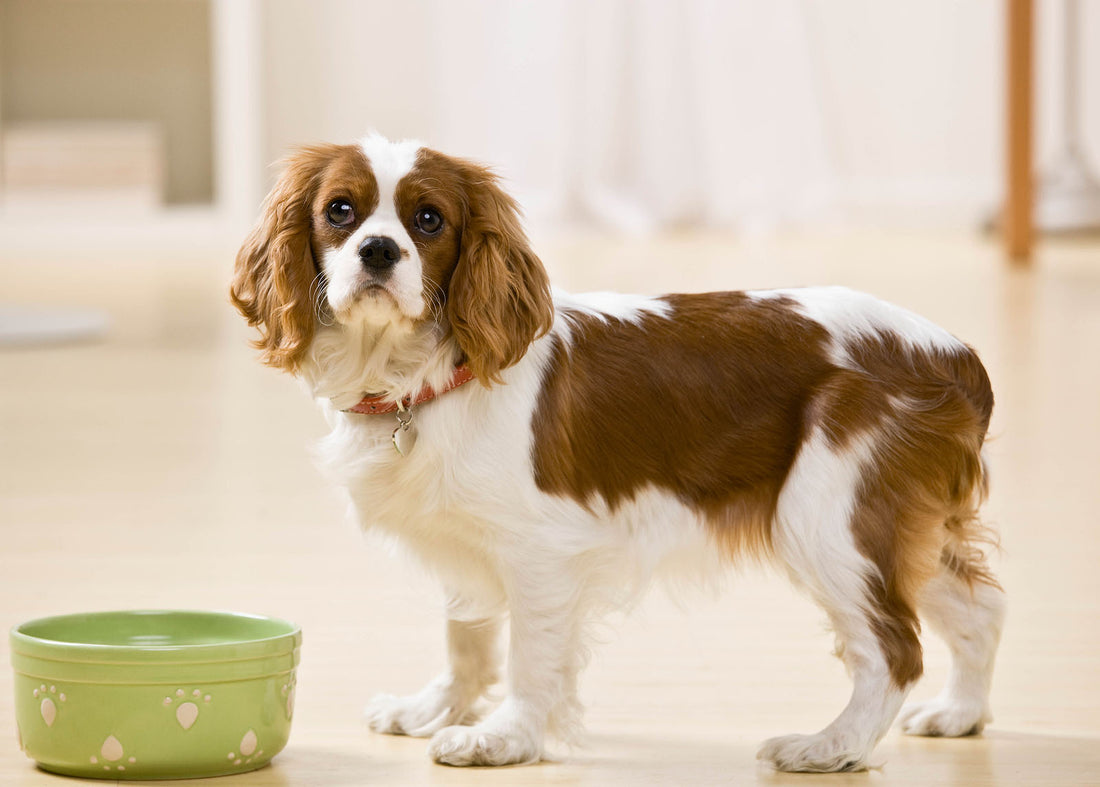
Tips if Your Dog Has Smelly Gas
Here’s a fun question for you…
If you could have one superpower, what would it be? If you’re like most folks across the US and Europe, invisibility and being able to fly are the top two. You’ll also find super strength, teleportation, and immortality high on the list too. But one superpower that’s not high on this list? Being able to clear the room with a single gassy toot.
So, if your pup does in fact have this superpower, chances are, it’s not too popular. In this article, we’re going to discuss 3 reasons your dog has smelly gas, and steps you can take to improve the air quality at home.
Nailing Down Those Noxious Fumes
The first thing to understand about--well, let’s be honest here--farts, is what they’re made of. Gassy toots aren’t just composed of a single gas, like methane. They’re actually composed of several different gasses.
The composition of intestinal gas can vary, according to Britannica, with 20-90% being Nitrogen, 10% Oxygen, up to 50% Hydrogen, 10-30% Carbon Dioxide, and 10% Methane. Hydrogen sulfide gas, which gives farts that super funny smell, can also be present.
There are 3 main causes of gas production within the digestive tract, eventually leading to those gasses getting expelled.
The two that contribute the most are air that is taken in and swallowed and gasses produced by bacteria as a byproduct of digestion. We’re going to talk about these two the most, because we can actually make some changes to those causes that can help.
The third cause of gas in the digestive tract is a result of the body’s normal processes. Exchange of gasses--primarily oxygen, hydrogen, carbon dioxide, and nitrogen--occurs regularly between parts of the digestive tract and blood vessels in the body.
Depending on gas concentration on one side or the other, a gas like oxygen might pass from the lumen of the intestines through the wall into the bloodstream, or may do the opposite, passing from the bloodstream, through the wall into the digestive tract as free gas.
This process is driven to some degree by gasses already present in the GI tract, but truly is a process that is happening all the time and we can otherwise do very little about.
But when it comes to direct intake of air and gas as a product of bacteria in the gut, we have more ability to better understand the causes and do something about them, so let’s talk about those more.

How Gulping Air Causes Gas
Air is for breathing, not swallowing, but tell that to an extremely athletic dog, a pup who wolfs his food down so fast that an equal amount of air probably goes with it, or one of our adorable smushy-faced breeds like Pugs, who are super cute, but weren’t blessed with wide-open airways.
Regular, intense exercise can lead to increased gulping of air, and more gas production. This is reported far more in sporting and eventing dogs who are regularly working or competing at a high level.
Some dogs may gulp down their food for a variety of reasons. Sometimes rescue pups used to surviving meal to meal may down their dinner in one fell swoop, afraid it might be taken away or eaten by someone else.
Competition for food and food-stealing behavior in multiple pet households may also lead to some dogs inhaling their food to make sure a housemate doesn’t get it. Then of course, there’s just some dogs that don’t understand how to savor the finer things in life by enjoying each bite.
Frenchies, Bostons, Pugs, and other brachycephalic smushy-faced breeds are some of my favorites to see in practice. Many of them have great dispositions and are usually happy little pups.
But these breeds with their snorty, snuffling breathing behavior are known to be big gas passers. Since their facial structure obstructs a lot of normal airflow, they end up swallowing a lot of air when they breathe.
This is due to three structural abnormalities we see in their airways, which are collectively termed “brachycephalic airway syndrome”. The first is that the nostrils are stenotic, or extremely narrowed. This makes it very hard to breathe through the nose. Second, the soft palate at the roof of the mouth is often much longer than normal, covering the back of the throat and airway contributing to a snoring noise and reduced airflow. Third, a tissue sac on each side in front of the vocal cords, called a laryngeal saccule, gets pulled down into the airway with each strained breath, further blocking airflow.
Because these pups can’t pull air in normally through the nose and mouth, they suck in air as often as they can, leading to swallowing of air, termed aerophagia.
Tips to Reduce Air Gulping
If you have a sporting or eventing dog, you may have to live with some of the toots, since they’re just a result of hard work and heavy breathing.
But for the average pup, just remember that exercise is a good thing, and cutting down on it will affect the other benefits that exercise has for health. Thirty minutes of walking per day is typically recommended as a daily dose of activity. If your pup is super gassy but is really just doing the average amount of activity, there’s likely another cause for your gas problem.
If your dog gulps down air while she eats, it’s important to find effective ways of slowing her down. If food competition is the issue, you might find she’ll feel “safer” eating in a separate part of the house. If you just have a greedy pup who simply doesn’t know the meaning of savoring his meals, a puzzle bowl or slow-feeding bowl can be helpful.
Puzzle bowls, also called slow-feeding bowls, have small nooks and crannies that kibble slides into, forcing a pup to slow down to get each little bit. Another trick that you can try is putting a heavy ball, like a billiards cue ball, inside the bowl. Your pooch will need to push the ball around in order to get to his food, slowing down his eating. These are also commercially available for just this purpose. Alternatively, you can also place a smaller bowl upside down inside your pup’s larger bowl for a similar effect.
Brachycephalic airway syndrome affects some smushy-faced pooches more than others. And besides adding to flatulence, the syndrome can also affect exercise tolerance, heat tolerance, and energy level. If a young Pug or Frenchie looks winded after a 10 minute walk and is breathing super heavy, there’s a problem.
There is a collection of surgical procedures commonly performed that can alleviate the stress these structural abnormalities place on an affected pup’s breathing. The opening of the nostrils can be widened, the elongated soft palate can be shortened, and the swollen, everted laryngeal saccules can actually be removed. Surgery is always a big thing to think about, but if your pup has a really hard time breathing and snores more during the day than at night, it’s worth discussing with your vet.
When Food Causes Fumes
If you ever wondered why beans are so often associated with gas problems, you’re about to find out.
While some food, like sulfur-containing veggies like cauliflower and broccoli, can directly lead to foul emissions when hydrogen sulfide gas is produced when they’re broken down in the intestines, a bigger cause of food-related farts are thanks to the bacteria in our gut.
Our digestive tracts have mixed populations of bacteria that are required to keep a healthy balance and aid in digestion. Under the right conditions and with certain nutrients, bacteria in the colon will produce gas as a result of fermentation.
Changes in the gut that leads to an overpopulation of gas-producing bacteria can also lead to an overproduction of gas. If your dog has gas, there’s a good chance something is going on with these gas-producing microbes.
But what causes these bacteria to produce gas? That’s where our beans come in.
If you take a simple sugar, like glucose, and put several such sugar molecules together, you get a slightly more complicated molecule called an oligosaccharide. Oligosaccharides cannot be digested and have to be broken down further first. But dogs and cats lack the enzymes necessary to digest many of them. Thus, our bacteria friends in the colon break them down eventually, making more gas.
Avoiding foods high in oligosaccharides can help avoid the toots. These foods include legumes like peas, beans, and soybeans. This is why beans have that stereotypical bad reputation. Check out the ingredient list on your pup’s food. Many of the popular grain-free diets get their carb content from legumes, peas, and beans, so they can be commonly-found ingredients.
Diets higher in certain types of fiber, called fermentable fiber, can slow down intestinal transit time, allowing more time for bacteria to digest nutrients and expel gas. Fiber content can vary greatly from diet to diet and higher amounts aren’t appropriate for every dog, so make sure to check out the ingredient label and chat with your vet if you have further dietary questions.

How to Beat the Food Toots
Here’s some tips to consider that can help to reduce food-related fumes.
Feed a Highly Digestible Diet
Highly digestible nutrients reduce food residues by allowing more absorption in the small intestine, leaving less substrate for bacterial fermentation in the colon.
Many special gastrointestinal diets are formulated with this in mind. Rice, for example, is one of the most highly digestible carbohydrate sources and is found in many sensitive stomach formulas.
Another consideration for diet is to keep fiber, soluble fiber specifically, to less than 5%. As mentioned, certain types of fiber can slow down intestinal contents and allow bacteria more time for fermentation. Examples of soluble fiber sources to keep an eye out for include: psyllium, pectin, guar gum, carrageenan, bran, and beet pulp. These should be included in the ingredients list for your pooch’s diet.
Many low residue formulas and prescription high-digestibility diets should already account for these fiber restrictions. It’s best to speak with your vet about what diet choice may be best for your pup.
Avoid Table Food
Table scraps can be a favorite treat for the family dog, but for many reasons, you should avoid this practice.
The variability in foods can affect bacterial populations leading to shifts in those microbes. We can also find that foods not tolerated well by pets can lead to GI inflammation, which also leads to bacterial changes, gas, and sometimes diarrhea.
Avoid Dairy
I love a cool glass of milk and one of my favorite snacks is a nice slice of gouda cheese (or five or six). But not everyone can enjoy dairy without side effects and dogs can be the same way. While many may not realize it, a large number of dogs (and cats surprisingly) are lactose intolerant.
Ingesting dairy products, including milk, cheese, and yogurt, can lead to some pretty foul smells. Now a small amount, like for a treat once in a while, is likely not an issue and some yogurt can have good probiotic properties, but keep an eye out: bad tooting problems after feeding dairy could be the cause of your woes.
Don’t Make Sudden Diet Changes
When changing diets, you should always do so slowly over several days to allow bacteria populations to readjust. I always recommend changing diets over about a 7 day period, to allow your pooch’s digestive system time to catch up.
Avoid Sulfur-Containing Vegetables
To keep that rotten eggs smell out of your house, avoid broccoli, cauliflower, brussels sprouts, and cabbage. Although nutritious veggies, these foods contain sulfur. When they’re digested, hydrogen sulfide gas is produced, contributing to that nasty dog gas smell.
Avoid Fruit
Fruits are pretty nutritious. Some, like blueberries, are high in antioxidants. But loading up on them too much can cause tooting problems, as they may not be well-digested by your pup. The same goes for any treats (or table food) made with high-fructose corn syrup. Fruits can have a high amount of soluble fiber, which as we discussed earlier can lead to excessive gas from bacterial fermentation. Remember, your dog’s body produces his own Vitamin C, and he doesn’t need to get any extra from fruit.
Avoid Legumes (Peas, Beans, etc.)
Legumes like peas, beans, and soybeans contain those pesky oligosaccharides we talked about, which can’t be digested and are only broken down by those gas producing bacteria in the colon. Grain-free diets are commonly chock full of legumes as a way of providing a carbohydrate source without using grains. Their popularity also has to be balanced against their association with a certain type of heart disease in dogs, which legumes are also thought to somehow be related to.
Take a Walk
Going for that healthy walk within 30 minutes of eating can be helpful for your pup to expel some of those gasses outside instead of stinking up your house. Light exercise helps to improve intestinal contractility, pushing out small bubbles of gas that are trapped in the intestinal tract and colon. Better out than in. But much better outside than inside the home.
If My Dog Has Gas, What Can I Give?
Carminatives
It might be a common line of thought to just pop your pup a Gas-X if he seems extra gassy, right?
Well, unfortunately, you may have limited success with some of these products and veterinarians don’t recommend them for the most part.
Simethicone (Gas-X), alpha-galactosidase (Beano), and bismuth subsalicylate (Pepto-Bismol) are medications collectively called carminatives. Carminatives are medicines that help to reduce flatulence.
While they can be very helpful for people, there are a few reasons to avoid their use in dogs.
Beano is a product to avoid simply because it contains enzymes only useful for human digestion, and will literally do nothing for your gassy pup.
While one or two small doses of Pepto may be okay, avoid further use without consulting with your vet. The salicylates in Pepto could cause stomach bleeding in some dogs, and the bismuth can make stools look black, which could also be mistaken for blood in the digestive tract. It can also be contraindicated with some medications your dog could be on, like the anti-inflammatory carprofen. As a special note, Pepto is considered outright toxic to our feline companions, and should never be given to a cat.
Simethicone is an anti-foaming agent, designed to reduce gas bubbles. While it is safe to give to dogs, it is not officially approved for use in pets and has no established dosage. Some veterinarians do believe it is most helpful in situations of dogs suffering from food bloat where foamy gas is actually trapped in the stomach. But it’s unlikely to be very helpful to reduce regular tooting, and it will not eliminate the odor.
Probiotics
Probiotics can be helpful from the perspective of helping to rebalance bacterial populations, especially if gas-producing bacteria are dominating the field. Thus in theory, you can reduce gas by reducing the proportion of gassy bacteria. This may be better in theory than reality, but probiotics can also be helpful in other ways with other digestive issues.
Digestive Enzymes
Digestive enzymes have been growing in popularity on both the human and pet front. While a healthy dog with no digestive issues likely won’t benefit much from supplementation with digestive enzymes, a gassy pup with digestive disturbance might find something like that to be helpful. But always remember to understand well what you’re feeding your pooch.
Yucca, Zinc Acetate, and Activated Charcoal
A majority of expelled gas is actually odorless, but it’s that 1-5% of hydrogen sulfide gas that clears out the living room during a party. There are a couple of ingredients that have some scientific evidence behind their ability to inactivate the hydrogen sulfide gas that’s responsible for that awful dog gas smell.
In a 2001 study in the Journal of the American Veterinary Medical Association (JAVMA), Yucca schidigera, zinc acetate, and activated charcoal were associated with an 86% reduction in hydrogen sulfide gas production when given in combination. It is important to note that the overall production of gas was not much affected, and dogs farted just as much. But at least the smelliest parts of their gas emissions were reduced.
But before you run out and buy a zinc supplement or charcoal tablets for your pup, there are a couple details to be aware of. Many zinc supplements are in the sulfate form, not the acetate form, and will not have the same beneficial effect. And while zinc is required by the body, too much of it can lead to toxicities and should be supplemented carefully through guidance from your vet.
While charcoal also seems promising at first, a further look into the JAVMA study shows that the specific reductions the ingredients caused in hydrogen sulfide gas produced was determined only in a lab setting using laboratory equipment.
Treats containing all three ingredients fed to dogs did reduce the foulness of emission significantly, but it’s hard to say which of the three contributed most to this in a living dog. One argument against using charcoal regularly for flatulence is that as a binding agent, a charcoal tablet has likely already been “used up” by the time it reaches the colon where all the bacteria are causing gas production.
When we use activated charcoal in veterinary practice, it is largely in a liquid form to try to absorb toxins from the stomach and upper intestinal tract before much absorption has taken place. It’s thought to do very little by the time anything reaches the colon.
That’s why in a practical sense, a supplement containing Yucca schidigera like No Toot may be worth trying the most. Yucca is very safe and can have a number of other health benefits.
Fennel Seed
Fennel seed is another safe ingredient that can be found in supplements that can aid with digestion and help with flatulence.
Some of its activity is thought to originate from the volatile oils it contains which help to ease intestinal cramping by encouraging motility and digestion. It can help to expel trapped gas more efficiently and reduces intestinal transit time, depriving colonic bacteria from being able to ferment more nutrients.

Clearing the Air (Instead of the Room)
While no one would want to be deprived of a superpower, your pup’s amazing ability to clear the room with one toot of gas really isn’t worth holding onto, and hopefully, some of these tips will be helpful to improve the air quality at home.
As we talked about, excess gas can have a lot to do with certain nutrients and ingredients in food. Navigating a food label can be confusing for many pet parents, so make sure to check with your vet if you’re not sure what you’re looking at.
It’s also really important to check with your pup’s doc before making any big changes in diet and before starting any new supplements to help with excess gas. Being on the same page with your vet is the best way to keep your pup healthy, happy, and your home free of those noxious odors.
JOIN OUR PACK
Follow us @NaturVet on social media to fill us in on any tips we might have missed. And, check out the rest of NaturVet.com. We’ll keep you up to date on all our latest pet resources, supplements, tips and tricks, and more – everything you need to be the best pet parent possible.






